Cloudy with a Chance of Certification
My Journey to AWS Cloud Practitioner
Preparing for the AWS Cloud Practitioner Certification exam was a journey of discipline and adaptation, using online learning platforms to master cloud concepts and AWS services. Despite challenges with time constraints and moments of doubt during the exam, I successfully earned the certification. Here's how I did it, and what I learned from it.
December 2024

Amazon Web Services (AWS) are among the largest Cloud Computing
providers. It is essential to understand the basics of its
services and cloud computing in general. Image credit: Dall-E
AI.
Over the past few years, I've gained some hands-on experience with Amazon Web Services (AWS), though it's been mostly sporadic and tied to specific tasks. The service I've used most often is the Simple Storage Service (S3), but I've also worked with CloudFront to invalidate caches, managed user permissions in IAM, and connected to databases in the cloud (RDS). While I working in a sports data company, I had my first touch points with Redis for caching and real-time analytics In personal side projects, I've set up and configured an Elastic Cloud Compute (EC2) micro instance free of charge, giving me a taste of AWS's flexibility and power. Despite this exposure, I'd never committed to pursuing AWS certifications, even though I'd often thought about it. This year, however, achieving the AWS Cloud Practitioner Certification became one of my annual goals for work, so I finally decided to give it a shot.
While I have a great deal of respect for those working in DevOps and cloud computing, I don't see myself moving into that space full-time. However, as a web developer, having a solid understanding of AWS specifics is still highly valuable. That said, I found the Cloud Practitioner material to be somewhat tedious at times, as it involves a significant amount of memorization of various Amazon services, which can feel more like learning by repetition than practical exploration.
Here's how I prepared for the exam, what I learned from the process, and what I'd do differently next time.
A Not So Brief Overview of AWS Cloud Practitioner Exam Topics
First, let's take a look at what the AWS Cloud Practitioner Certification in general. The exam is designed to test foundational knowledge of cloud concepts, AWS services, and their applications in business environments. It is primarily aimed at individuals in non-technical roles or those new to cloud computing. Though it certainly serves as a stepping stone to more advanced AWS certifications.

The four major domains of the AWS Cloud Practitioner exam:
Cloud Concepts, Security and Compliance, Cloud Technology and
Services, and Billing, Pricing, and Support.
You can find all the details in the AWS Certified Cloud Practitioner exam guide. Here's a not so brief overview of the four main domains:
1. Cloud Concepts
This domain assesses the understanding of the basic concepts of cloud computing and AWS. Key areas include:
- The benefits of cloud computing (e.g., scalability, elasticity, cost-efficiency).
- Different cloud deployment models (public, private, hybrid).
- The six core advantages of AWS: pay-as-you-go pricing, high availability, security, scalability, elasticity, and speed.
2. Security and Compliance
This domain focuses on the AWS security framework and shared responsibility model. Topics include:
- The AWS Shared Responsibility Model (customer vs. AWS responsibilities).
- Key security services such as AWS Identity and Access Management (IAM), AWS Shield, and AWS WAF.
- Concepts of data encryption and compliance frameworks (e.g., GDPR, HIPAA).
3. Cloud Technology and Services
This is the largest domain and tests knowledge of AWS core services and their use cases. Topics include:
- AWS Compute services such as EC2, Lambda, and Elastic Beanstalk.
- Storage options like S3, EBS, and Glacier.
- Database services such as RDS, DynamoDB, and Redshift.
- Networking basics, including VPCs, CloudFront, and Route 53.
- Monitoring and management tools like CloudWatch and Trusted Advisor.
4. Billing, Pricing, and Support
This domain covers AWS billing models and cost management tools. Key areas include:
- AWS pricing models (On-Demand, Reserved Instances, Spot Instances).
- Cost management tools like AWS Budgets, Cost Explorer, and Trusted Advisor.
- The AWS Free Tier and its limitations.
- Total Cost of Ownership (TCO) and return on investment (ROI) concepts.
- AWS support plans and the AWS Marketplace for third-party solutions.
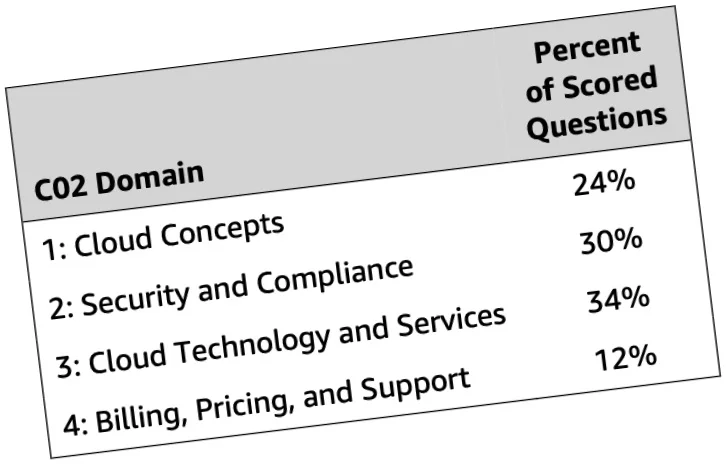
This table from the AWS exam guide shows how much the
individual areas contribute to the total score. Cloud Technology
and Services are the most important, followed by Security and
Compliance, Cloud Concepts, and Billing, Pricing, and Support.
Starting with Company Resources
My journey began with a course organized by my company and access to an AWS Skillbuilder account provided by my employer. This seemed convenient at first, as I could study during work hours. However, the major limitation was that I could only access Skillbuilder through the company network or VPN, meaning I had to use my company laptop. As I started wanting to study more during my personal time, this restriction became an impediment. I wanted the freedom to study on my personal devices, like my iPad Pro or MacBook Air.
My Experience with AWS Skillbuilder
AWS Skillbuilder is rightly regarded as the preferred course tool for preparing for AWS certifications, thanks to its direct connection to AWS and its team of knowledgeable tutors.
The video sections are well-produced and explain key concepts in a clear, accessible manner, making it easier to grasp foundational cloud principles. One of Skillbuilder's standout features is its interactive lab sessions, which guide you through the AWS interface and provide hands-on exercises to solve in the actual AWS web console. These practical tasks are invaluable for reinforcing what you've learned and building real-world skills.
Additionally, Skillbuilder offers extensive exam preparation resources, including practice exams that closely mirror the actual test. These mock exams not only help you assess your readiness but also highlight areas that need improvement, ensuring you're well-prepared when exam day arrives.
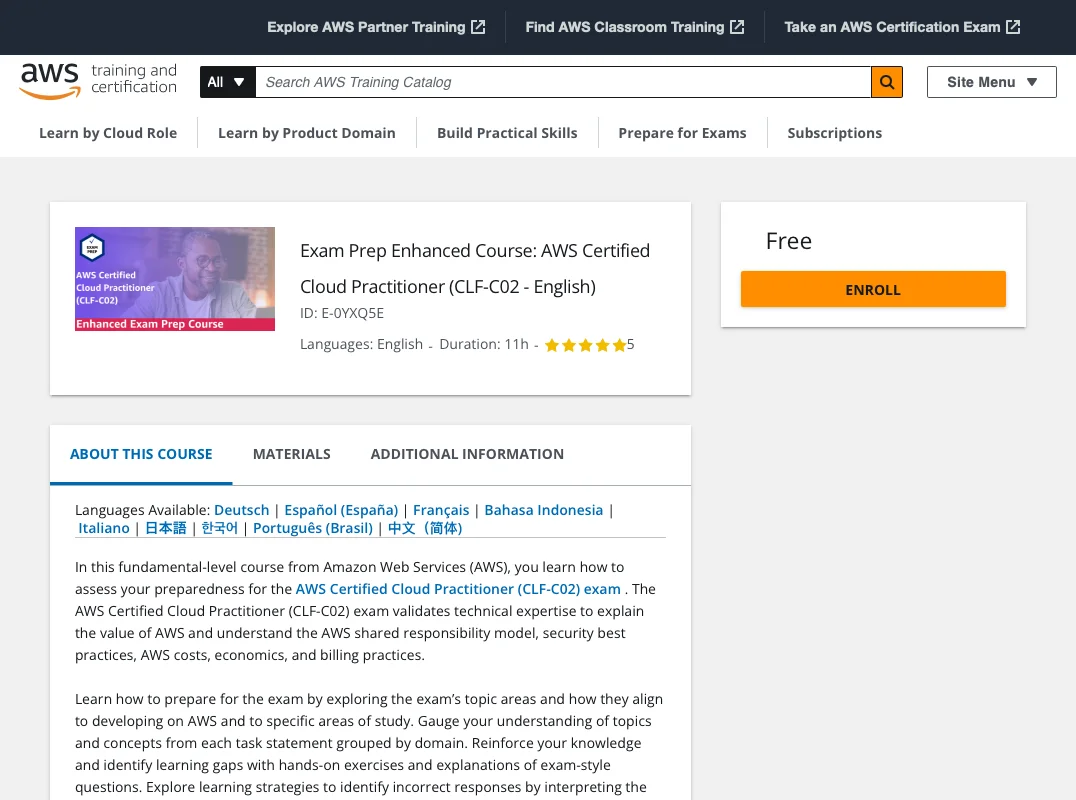
One of many possible course options on AWS Skillbuilder to
prepare for the Cloud Practitioner exam.
The course featured video material presented by three different AWS tutors, each with a distinct teaching style and personality. My experience with these instructors was a mix of entertainment, frustration, and occasional disbelief.
The Tutors
The "Let's Get Ready to Rumble" Guy
One of the tutors was a larger-than-life personality who, at times, came across as a bit too theatrical for my liking. He tried to inject energy into the course with antics like mimicking a boxing announcer's "Let's get ready to rummmmmble!" shtick. And he did it twice!
While I can appreciate the effort to make the material engaging, his delivery felt a bit over-the-top and distracted me from the content.
The No-Nonsense Lady
The second tutor was a lady who stood out as the most competent and balanced of the trio. She had a professional, no-nonsense demeanor that made her explanations clear and easy to follow. She still managed to instill the necessary excitement for real advantages and emphasize important items worth going back to. I found her segments to be the most valuable, as she focused on delivering the material without unnecessary theatrics.
The Overly Enthusiastic Gentleman
Finally, there was the tutor with the delightful South African accent, whose relentless enthusiasm was both charming and, at times, overwhelming. He had an uncanny ability to get excited about the most mundane aspects of AWS. A particular highlight was his sheer joy while introducing the "6 R's of cloud migration strategy." When he enthusiastically exclaimed about "Rehost," "Replatform," "Retire," "Retain," "Repurchase," and "Refactor," I found myself stunned. I couldn't fathom how anyone could be genuinely thrilled by these terms, but his exuberance was undeniable.
The Content
The course itself was well-structured and used relatable analogies to explain key cloud concepts. One metaphor that stood out was comparing cloud infrastructure to a self-service café. This analogy effectively illustrated how clients, servers, queues, roles, and scalability work together, making the technical content more accessible.
While some of the delivery styles were distracting, the explanations and examples provided a solid foundation for understanding AWS basics.
Hands-On Labs
The hands-on lab sessions guide you through using the AWS web console to complete various tasks. However, I noticed that the instructions for the labs didn't always match the current UI of the console. Some elements had different names, while others were located in tabs or sections that differed from the screenshots and descriptions in the instructions.
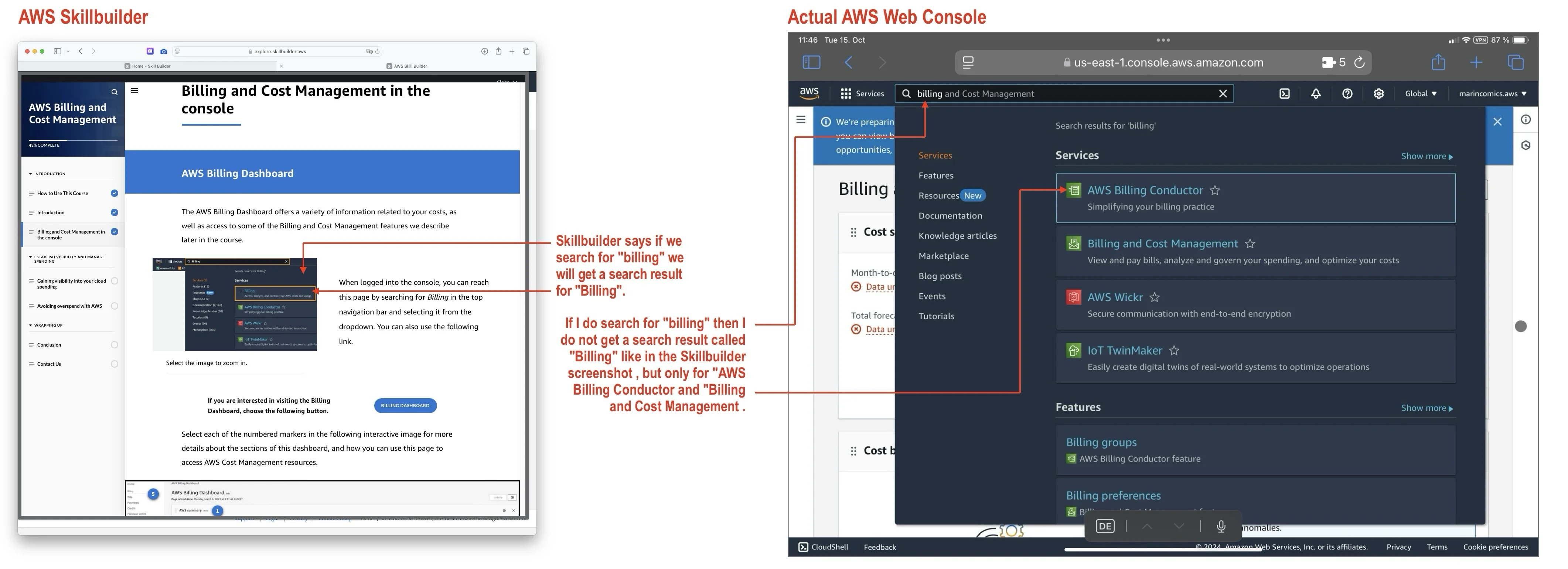
Some of the lab instructions in AWS Skillbuilder didn't match
the current UI of the AWS Web Console, making it challenging to
complete the tasks.
At first, this discrepancy was a bit baffling and frustrating, but I came to see it as an unexpected advantage. It forced me to actively engage with the AWS interface, seek out features, and use them consciously rather than mindlessly following step-by-step instructions. This extra effort helped me better understand the platform and reinforced my knowledge in a way that simply going through the motions wouldn't have achieved. It turned what could have been a passive exercise into a more meaningful learning experience.
Turning to A Cloud Guru
To overcome the SSO and VPN restrictions imposed on AWS Skillbuilder, I subscribed to A Cloud Guru (Pluralsight). This turned out to be a great decision. The platform offered structured material, practice exams, and detailed explanations for any incorrect answers. These explanations were particularly useful in helping me understand the nuances of AWS services and concepts from a different perspective and in a slightly different order than on Skillbuilder.
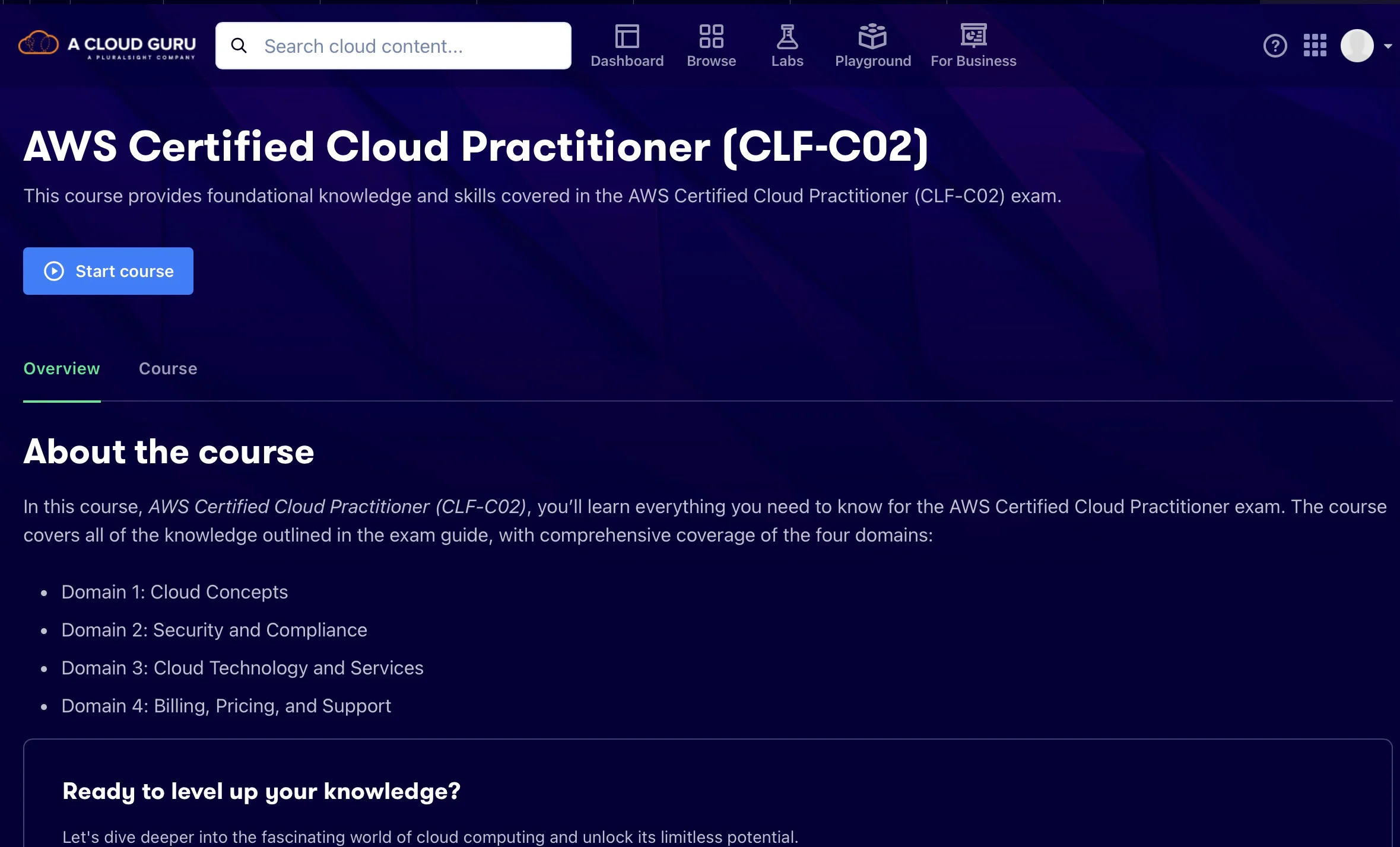
A Cloud Guru offers comprehensive courses for AWS
certifications, including the AWS Cloud Practitioner exam. It is
part of the Pluralsight learning platform.
Additionally, I found a free practice exam on W3 Schools. However, I quickly realized it was not a true reflection of the actual exam's difficulty. It had a few typos and didn't challenge me as much as A Cloud Guru's resources.
Taking Notes to Learn
One of my preferred study methods while preparing for the Certification was taking extensive handwritten notes while watching videos and listening to explanations. This approach helped me process the material more deeply by reformulating concepts in my own words. The physical act of writing also kept me engaged and attentive during long video sessions, providing a tactile, active element to balance the otherwise passive experience of sitting through instructional videos. Whether you use a simple paper notebook with your favorite pen or an electronic note-taking device, the act of writing can make a significant difference in retaining information.
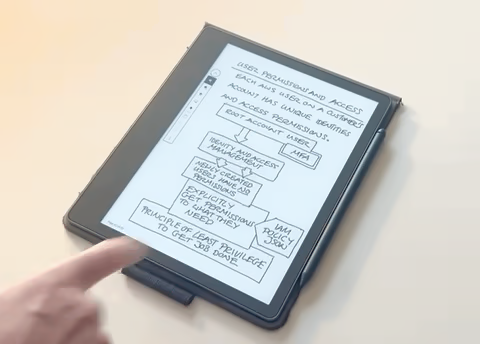
I had three notebooks of around 50 to 80 pages each, filled
with notes on AWS services, concepts, and practice questions. I
used a
Kindle Scribe
for my notes but you can use a paper notebook instead.
For my preparation, I opted to use a Kindle Scribe with its e-ink screen and stylus, an electronic note-taking device that mimics the feel of handwriting. While it was an excellent tool for capturing my thoughts and organizing my notes digitally, it had some drawbacks compared to traditional paper notebooks. Unlike flipping through paper pages for a quick overview, navigating notes on an e-ink device is more sequential and requires more effort due to the lag in screen refresh. Still, having a centralized, portable collection of notes proved invaluable for revisiting material and reinforcing what I'd learned, helping to solidify key concepts in my memory.
Booking the Exam
When it came time to book the exam, I chose the SPC Gschwandtner test center in Vienna. It was the most convenient location for me as it is directly opposite the coworking space I frequent (The Social Hub, or TSH). The booking process through my AWS account was as straightforward as logging in on AWS, entering the city you want to take the exam in, choosing a test center close-by, booking the time and date and paying for it. The price was around 100 USD.

I booked the AWS Cloud Practitioner exam at the SPC
Gschwandtner test center in Vienna because of its convenient
location.
Final Preparation: A Focused Effort
In the final stretch, I dedicated eight hours over the three days leading up to the exam to revisiting my notes and watch a six-hour AWS Cloud Practitioner prep video on YouTube. This intensive review was invaluable in refreshing my memory and consolidating key concepts because it provided an overview of the same material again from a different perspective.
Exam Day: A Mix of Confidence and Confusion
On exam day, I arrived at the test center feeling prepared but nervous. After filling out paperwork, verifying my ID, and storing my belongings in a locker, I was seated in a quiet classroom with a terminal for the test.
At first, I was overwhelmed. The questions seemed alien, and I wondered if I had accidentally registered for the wrong exam. However, as I progressed, I started recognizing familiar topics and piecing together answers. The multiple-choice format, combined with the ability to revisit and revise answers, worked in my favor. I also noticed similarities between questions that helped me infer some correct answers.
That said, there were some areas I hadn't prepared for at all. For example, I encountered a question about AWS Detective - a service I hadn't studied. (For the record, it is indeed a real product, as I discovered later.)

Celebrating my success with the AWS Cloud Practitioner!
Credits: Dall-E AI.
Passing the Exam
When I was done with the exam, I was presented with a survey about the testing experience. I found this hilarious. I had answered 65 questions in more than 90 minutes, and now they wanted me to fill out a survey about the testing experience. And they didn't even show me the results of the exam. I had to complete the survey before I could see my results. I rushed through the survey as quickly as possible so I could see my results.
And after the exam was over, I realized that I had forgotten to go to the bathroom before starting. I had to hold it in for the entire duration of the exam. I was so focused on the questions that I didn't even notice the discomfort until the exam was over.
In the end, I passed the exam (Whoohoo!), and I'm thrilled with the result. The feeling of accomplishment after months of effort was deeply satisfying. However, my preparation could have been much more efficient.
Let's see what I learned from this...
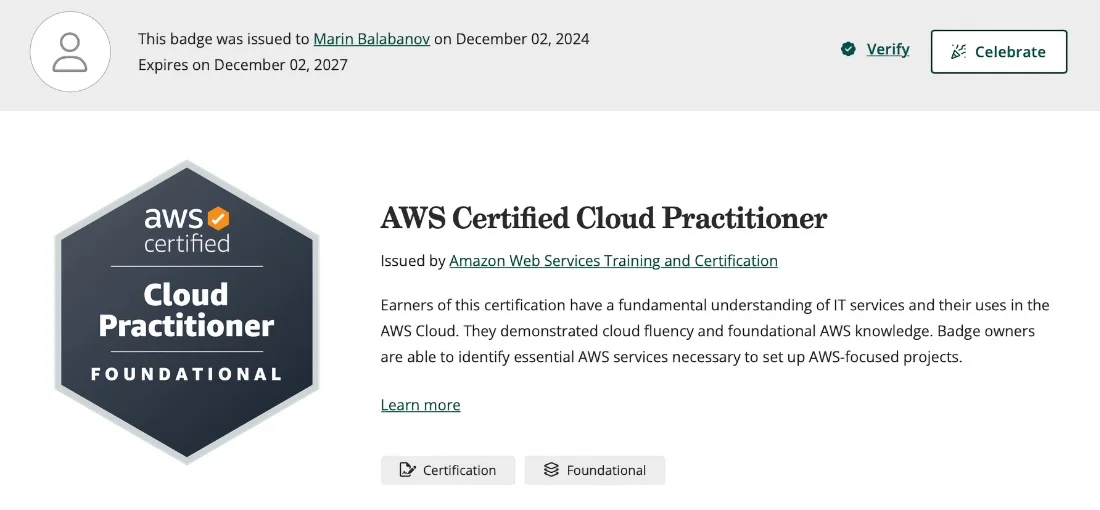
Once you have the official certificate, you can share it
through credly.com.
Here's mine!
Reflections and Lessons Learned
The entire process took me about two and a half months, which in hindsight was too long. The protracted timeline led to me forgetting material I had studied early on. I believe I could have condensed my preparation into one month with a more focused schedule, such as studying for an hour each workday and two hours on weekends.
Here are my key takeaways for anyone preparing for the AWS Cloud Practitioner Certification:
-
Use Flexible Study Resources
Platforms like A Cloud Guru provide the freedom to study anywhere, anytime, and offer comprehensive explanations for practice questions. Don't rely solely on employer-provided resources if they're restrictive. -
Take Multiple Practice Exams
Practice exams are crucial. They not only test your knowledge but also familiarize you with the exam format and question style. Aim for high-quality resources with detailed feedback. -
Condense Your Preparation Timeline
A shorter, more intense study period prevents knowledge decay and maintains momentum. Balance study time with your daily schedule to avoid burnout. -
Don't Panic During the Exam
The questions may seem confusing at first, but look for patterns, use the ability to revisit answers, and eliminate obvious wrong options.
Surviving the Cloud: Final Thoughts
Preparing for and passing the AWS Cloud Practitioner Certification exam was a rewarding experience. It reinforced my understanding of AWS services and gave me a sense of achievement. While the journey had its challenges, it taught me valuable lessons about preparation, focus, and perseverance. If you're considering this certification, I encourage you to go for it - with the right resources and strategy, success is well within reach.
Despite the advantages of traditional paper notebooks, I've grown to really appreciate note-taking devices for their convenience and versatility. By taking hand-written notes, I engage with the study material much more actively which helps process and memorize it more effectively.
After successfully completing the AWS Cloud Practitioner exam, I decided to reward myself with a Remarkable 2 tablet and its accompanying keyboard case. This device has become a staple in my study and productivity routine.
I'm now looking forward to exploring more advanced AWS certifications and deepening my cloud computing knowledge. The journey continues, and I'm excited to see where it takes me next.
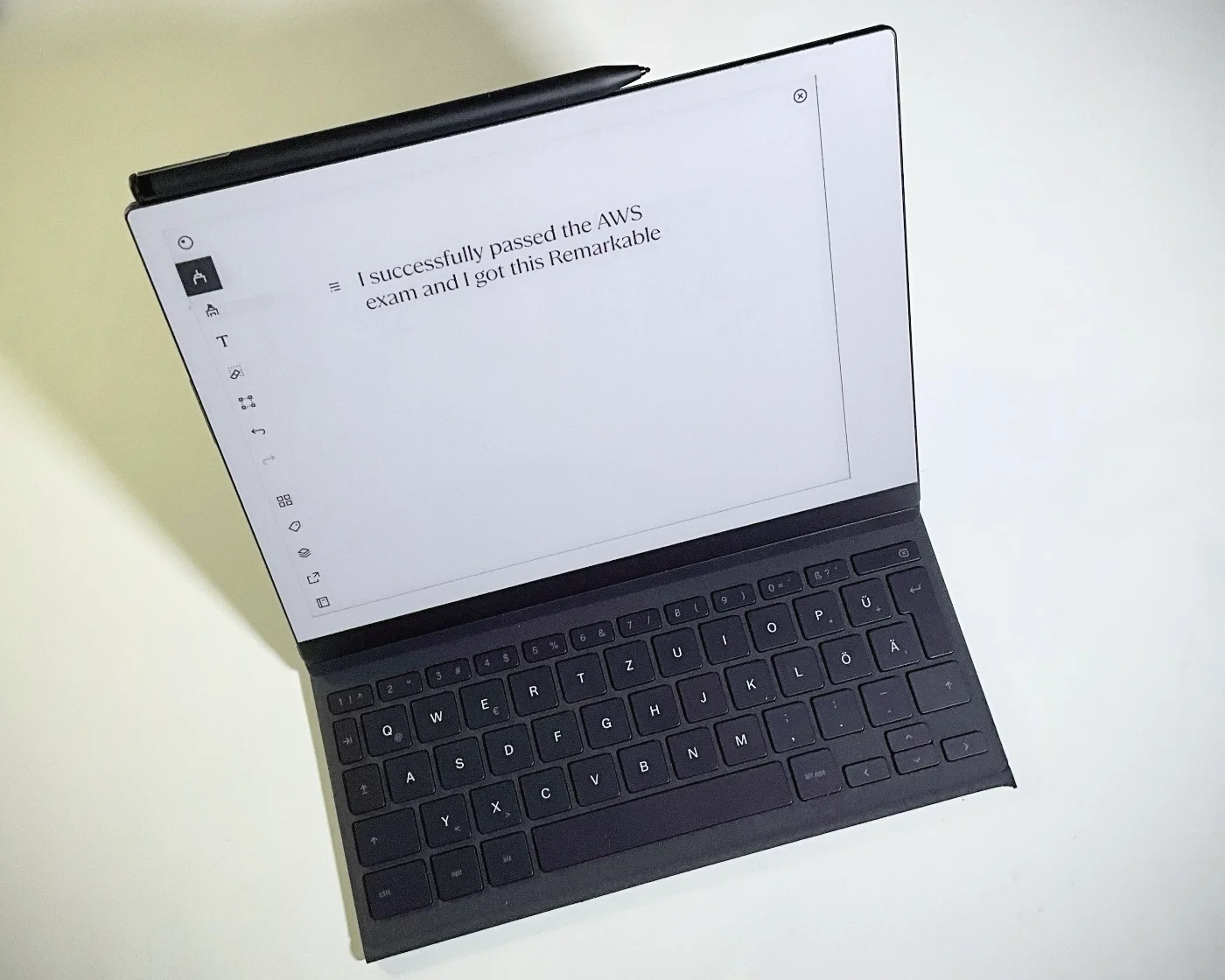
My Remarkable 2 tablet has become my new tool for digital
note-taking to enhance my study routine.